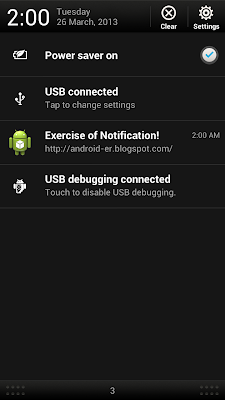package com.example.androidnotificationbuilder;
import android.app.Activity;
import android.app.Notification;
import android.app.NotificationManager;
import android.app.PendingIntent;
import android.content.Context;
import android.content.Intent;
import android.net.Uri;
import android.os.Bundle;
import android.view.View;
import android.view.View.OnClickListener;
import android.widget.Button;
public class MainActivity extends Activity {
private static final int MY_NOTIFICATION_ID=1;
NotificationManager notificationManager;
Notification myNotification;
private final String myBlog = "http://android-er.blogspot.com/";
@Override
protected void onCreate(Bundle savedInstanceState) {
super.onCreate(savedInstanceState);
setContentView(R.layout.activity_main);
Button buttonSend = (Button)findViewById(R.id.send);
buttonSend.setOnClickListener(new OnClickListener(){
@Override
public void onClick(View arg0) {
Context context = getApplicationContext();
Intent myIntent = new Intent(Intent.ACTION_VIEW, Uri.parse(myBlog));
PendingIntent pendingIntent = PendingIntent.getActivity(
MainActivity.this,
0,
myIntent,
Intent.FLAG_ACTIVITY_NEW_TASK);
myNotification = new Notification.Builder(context)
.setContentTitle("Exercise of Notification!")
.setContentText("http://android-er.blogspot.com/")
.setTicker("Notification!")
.setWhen(System.currentTimeMillis())
.setContentIntent(pendingIntent)
.setDefaults(Notification.DEFAULT_SOUND)
.setAutoCancel(true)
.setSmallIcon(R.drawable.ic_launcher)
.build();
notificationManager = (NotificationManager)getSystemService(Context.NOTIFICATION_SERVICE);
notificationManager.notify(MY_NOTIFICATION_ID, myNotification);
}});
}
}
<LinearLayout xmlns:android="http://schemas.android.com/apk/res/android"
xmlns:tools="http://schemas.android.com/tools"
android:layout_width="match_parent"
android:layout_height="match_parent"
android:paddingBottom="@dimen/activity_vertical_margin"
android:paddingLeft="@dimen/activity_horizontal_margin"
android:paddingRight="@dimen/activity_horizontal_margin"
android:paddingTop="@dimen/activity_vertical_margin"
android:orientation="vertical"
tools:context=".MainActivity" >
<TextView
android:layout_width="wrap_content"
android:layout_height="wrap_content"
android:text="@string/hello_world" />
<Button
android:id="@+id/send"
android:layout_width="fill_parent"
android:layout_height="wrap_content"
android:text="Send a Notification" />
</LinearLayout>
Note: minSdkVersion have to be set ="16".

Title: Example of using Notification.Builder
Rating: 100% based on 99998 ratings. 10 user reviews.
Post by 11:10 AM
Rating: 100% based on 99998 ratings. 10 user reviews.
Post by 11:10 AM






.jpg)
.jpeg)
.jpg)
.jpg)
.jpg)
.jpg)
.jpg)
.jpeg)

.jpg)
0 comments:
Post a Comment